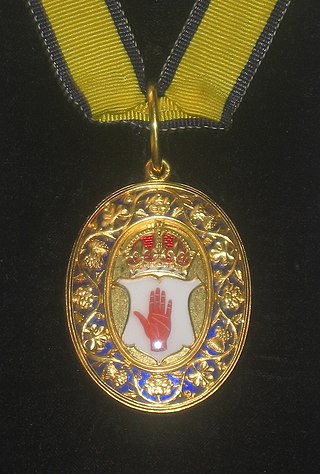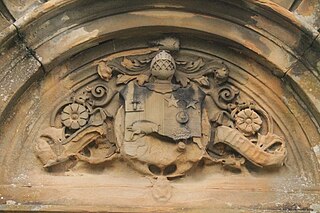
A baronet or the female equivalent, a baronetess, is the holder of a baronetcy, a hereditary title awarded by the British Crown. The title of baronet is mentioned as early as the 14th century; however, in its current usage it was created by James I of England in 1611 as a means of raising funds for the crown.
There have been 18 baronetcies created for persons with the surname Campbell, six in the Baronetage of Nova Scotia and twelve in the Baronetage of the United Kingdom.

The Dalyell Baronetcy in the Baronetage of Nova Scotia was created 7 November 1685 for a Scottish General, Thomas Dalyell of the Binns. The succession of the title is unusual in that, in default of heirs male, it can pass by special remainder to tailzie succeeding him in the estate of The Binns.
Nineteen baronetcies have been created for persons with the surname Hamilton, eight in the Baronetage of Nova Scotia, one in the Baronetage of England, five in the Baronetage of Ireland, one in the Baronetage of Great Britain and four in the Baronetage of the United Kingdom. As of 2008 two creations are extant, two are dormant, two are either extinct or dormant and twelve extinct.

There have been four baronetcies created for persons with the surname Baird, two in the Baronetage of Nova Scotia and two in the Baronetage of the United Kingdom.
The Duff, later Duff Gordon Baronetcy, of Halkin in the County of Aberdeen, is a title in the Baronetage of the United Kingdom. It was created on 12 November 1813 for James Duff, British Consul in Cádiz, with remainder to his nephew, William Gordon. Duff died unmarried in 1815 and was succeeded according to the special remainder by his nephew, the second Baronet, who assumed the additional surname of Duff on succeeding to the title. He was the second son of Lord Rockville, fourth son of the 2nd Earl of Aberdeen. Duff Gordon sat as Member of Parliament for Worcester.
There have been ten baronetcies created for persons with the surname Mackenzie, seven in the Baronetage of Nova Scotia and three in the Baronetage of the United Kingdom. Four of the creations are extant as of 2010.
Sir James Campbell, 2nd Baronet of Ardkinglass, was a British Army officer and Scottish politician who sat in the Parliament of Scotland from 1703 to 1707 and in the British House of Commons from 1707 to 1741.

There have been four baronetcies created for persons with the surname Hope, three in the Baronetage of Nova Scotia and one in the Baronetage of the United Kingdom. As of 2010 one creation is extant, one dormant and two extinct.
There have been eight baronetcies created for persons with the surname Graham, two in the Baronetage of Nova Scotia, two in the Baronetage of England, one in the Baronetage of Great Britain and three in the Baronetage of the United Kingdom.

There have been two baronetcies created for members of the Codrington family, one in the Baronetage of Great Britain and one in the Baronetage of the United Kingdom. The family was for a long time connected with Dodington Park.
The Edmonstone Baronetcy, of Duntreath in the County of Stirling, is a title in the Baronetage of Great Britain. It was created 20 May 1774 for Archibald Edmonstone, 11th of Duntreath, Member of Parliament for Dunbartonshire and Ayr Burghs. He was succeeded by his third but eldest surviving son, the second Baronet. He represented Dunbartonshire and Stirlingshire in the House of Commons. On his death the title passed to his eldest son, the third Baronet. He was a writer and traveller. He died without surviving issue and was succeeded by his half-brother, the fourth Baronet. He was an admiral in the Royal Navy and Member of Parliament.
The Maxwell, later Stirling-Maxwell, later Maxwell Macdonald Baronetcy, of Pollock in the County of Renfrew, is a title in the Baronetage of Nova Scotia. It was created on 12 April 1682 for John Maxwell, with remainder to the heirs of the body. In 1707 he was given a new patent extending the remainder to heirs of entail in his lands and estates. Maxwell was Lord Justice Clerk of Scotland from 1699 to 1702, and Rector of the University of Glasgow from 1691 to 1718.
There have been four baronetcies created for people with the surname Innes, three in the Baronetage of Nova Scotia and one in the Baronetage of the United Kingdom. Three of the creations are extant as of 2010.
There have been four baronetcies created for persons with the surname Seton, all in the Baronetage of Nova Scotia. As of 2008 one creation is extant, one dormant and two extinct.
There have been three baronetcies created for persons with the surname Maitland, two in the Baronetage of Nova Scotia and one in the Baronetage of the United Kingdom. Two of the creations are extant as of 2008 while the other is either dormant or extinct.
Sir James Campbell was a Scottish officer of the British Army, and author of Memoirs of Sir James Campbell of Ardkinglas, written by Himself. Until 1810 he was known as James Callander. While not a baronet, as he claimed, he used the title "Sir". Campbell was 5th Laird of Craigforth and 15th Laird of Ardkinglas.

Ardkinglas House is a Category A listed country house on the Ardkinglas Estate in Argyll, Scotland. The estate lies on the eastern shore of Loch Fyne, and the house is located close to the village of Cairndow. Dating back to the 14th century and originally a Campbell property, the estate now covers more than 12,000 acres (4,900 ha) of rolling hills and landscaped parkland. The centre of the estate was Ardkinglas Castle until this was replaced by a new house in the 18th century. This house was itself replaced by the present Ardkinglas House in the early 20th century, designed by Sir Robert Lorimer for Sir Andrew Noble. It remains the property of the Noble family, and is open to the public on a limited basis. The woodland gardens are open all year round.
Adam Livingston, was a Scottish soldier and politician who sat in the House of Commons from 1772 to 1780.